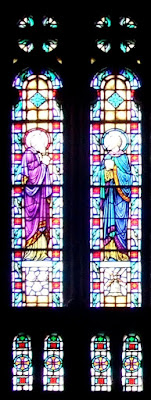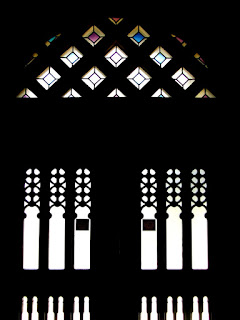Dearborn Township was established the same year and the interior Dearbornville founded in 1836. At that time, Fr. O’Kavanaugh, pastor of Detroit's Most Holy Trinity Parish, traveled to Dearbornville and celebrated Mass in the homes of Irish-Catholic immigrants. Locals began the process of establishing their own parish in 1840. Eight years later, with the support of Fr. John Farnam, what was then called St. John's Parish was established.

Fr. Patrick Kelly, previously an assistant to Fr. Richard, was assigned pastor on April 26, 1856. He later changed his name to O'Kelley to distinguish himself from the area's many Kelly families. Father O'Kelley died on October 7, 1858, and Mt. Kelly Cemetery, a mile northwest of the church, was established in his memory. Fr. O'Kelley's remains were interred beneath the cemetery chapel. Fr. O'Kelley Knights of Columbus, representing Dearborn and Dearborn Heights, also bears his name.
| Chapel on a hill in the small cemetery - source |
In 1874, the church was moved but soon underwent massive renovations to the point that only the original frame and steeple remained. The renovations were completed the following year and the pastor, Fr. Matthew Schaeken, sought to consecrate himself and the parish to the Sacred Heart of Jesus. Bishop Borgess soon came and rededicated the parish as Sacred Heart.



The church wasn't completed for another two decades until the stained-glass windows were added. A parish high school opened in 1954 but closed in the mid 1970s. The grade school remains in operation today.


A medallion of the Sacred Heart of Jesus above the main doorway; an excerpt from George Washington's 'Prayer for the United States' in the vestibule


Several plaques in the vestibule remember previous pastors, veterans, and benefactors respectively.




St. Cecilia, along with other saints and angels, above the choir loft.

Images of saints appear in the clerestory and transept windows




Painted Stations of the Cross line the walls and are framed by windows depicting scenes from the Gospels.




At some point, the main altar was moved, the choir and organ are seated where the high altar once stood.

The tabernacle stands at what was once a side altar; a large crucifix and baptismal font on the opposite side.


The Blessed Mother stands in the east transept; St. Joseph & Child Jesus on the west side


A museum houses artifacts from the parish and is open after most weekend Masses. Daily Mass is offered at 9:00am, Monday-Friday. Saturday Vigil Mass is at 4:30pm preceded by Reconciliation at 3:00pm; Sunday Mass is at 7:30am, 9:30am, and 11:30am.


For more info: parish website
News article: AOD Changing Lives Together



Church with historical interest requires more attention. Old churches have high historical value but more chance of damage. If you are concern about the ancient church in your community we are here with you. Our church loan provider offers lowest interest loan to preserve the historical churches.
ReplyDelete